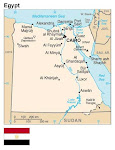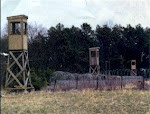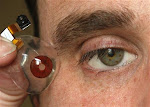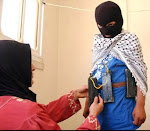 WASHINGTON - The Bush administration is likely to move its research on one of the most contagious animal diseases from an isolated island laboratory to the U.S. mainland near herds of livestock, raising concerns about a catastrophic outbreak.Skeptical Democrats in Congress are demanding to see internal documents they believe highlight the risks and consequences of the decision. An epidemic of the disease, foot and mouth, which only affects animals, could devastate the livestock industry.One such government report, produced last year and already turned over to lawmakers by the Homeland Security Department, combined commercial satellite images and federal farm data to show the proximity to livestock herds of locations that have been considered for the new lab. "Would an accidental laboratory release at these locations have the potential to affect nearby livestock?" asked the nine-page document. It did not directly answer the question.A simulated outbreak of the disease — part of an earlier U.S. government exercise called "Crimson Sky" — ended with fictional riots in the streets after the simulation's National Guardsmen were ordered to kill tens of millions of farm animals, so many that troops ran out of bullets. In the exercise, the government said it would have been forced to dig a ditch in Kansas 25 miles long to bury carcasses. In the simulation, protests broke out in some cities amid food shortages."It was a mess," said Sen. Pat Roberts, R-Kan., who portrayed the president in the 2002 exercise. Now, like other lawmakers from the states under consideration, Roberts supports moving the government's new lab to his state. Manhattan, Kan., is one of five mainland locations under consideration. "It will mean jobs" and spur research and development, he says.
WASHINGTON - The Bush administration is likely to move its research on one of the most contagious animal diseases from an isolated island laboratory to the U.S. mainland near herds of livestock, raising concerns about a catastrophic outbreak.Skeptical Democrats in Congress are demanding to see internal documents they believe highlight the risks and consequences of the decision. An epidemic of the disease, foot and mouth, which only affects animals, could devastate the livestock industry.One such government report, produced last year and already turned over to lawmakers by the Homeland Security Department, combined commercial satellite images and federal farm data to show the proximity to livestock herds of locations that have been considered for the new lab. "Would an accidental laboratory release at these locations have the potential to affect nearby livestock?" asked the nine-page document. It did not directly answer the question.A simulated outbreak of the disease — part of an earlier U.S. government exercise called "Crimson Sky" — ended with fictional riots in the streets after the simulation's National Guardsmen were ordered to kill tens of millions of farm animals, so many that troops ran out of bullets. In the exercise, the government said it would have been forced to dig a ditch in Kansas 25 miles long to bury carcasses. In the simulation, protests broke out in some cities amid food shortages."It was a mess," said Sen. Pat Roberts, R-Kan., who portrayed the president in the 2002 exercise. Now, like other lawmakers from the states under consideration, Roberts supports moving the government's new lab to his state. Manhattan, Kan., is one of five mainland locations under consideration. "It will mean jobs" and spur research and development, he says.The other possible locations for the new National Bio-and Agro-Defense Facility are Athens, Ga.; Butner, N.C.; San Antonio; and Flora, Miss. The new site could be selected later this year, and the lab would open by 2014. The numbers of livestock in the counties and surrounding areas of the finalists range from 542,507 in Kansas to 132,900 in Georgia, according to the Homeland Security study.Foot-and-mouth virus can be carried on a worker's breath or clothes, or vehicles leaving a lab, and is so contagious it has been confined to Plum Island, N.Y., for more than a half-century — far from commercial livestock. The existing lab is 100 miles northeast of New York City in the Long Island Sound, accessible only by ferry or helicopter. Researchers there who work with the live virus are not permitted to own animals at home that would be susceptible, and they must wait at least a week before attending outside events where such animals might perform, such as a circus.The White House says modern safety rules at labs are sufficient to avoid any outbreak. But incidents in Britain have demonstrated that the foot-and-mouth virus can cause remarkable economic havoc — and that the virus can escape from a facility.An epidemic in 2001 devastated Britain's livestock industry, as the government slaughtered 6 million sheep, cows and pigs. Last year, in a less serious outbreak, Britain's health and safety agency concluded the virus probably escaped from a site shared by a government research center and a vaccine maker. Other outbreaks have occurred in Taiwan in 1997 and China last year and in 2006.If even a single cow signals an outbreak in the U.S., emergency plans permit the government to shut down all exports and movement of livestock. Herds would be quarantined, and a controlled slaughter could be started to stop the disease from spreading.
Infected animals weaken and lose weight. Milk cows don't produce milk. They remain highly infectious, even if they survive the virus.The Homeland Security Department is convinced it can safely operate the lab on the mainland, saying containment procedures at high-security labs have improved. The livestock industry is divided. Some experts, including the former director at the aging Plum Island Animal Disease Center, say research ought to be kept away from cattle populations — and, ideally, placed where the public already has accepted dangerous research.
The former director, Dr. Roger Breeze, suggested the facility could be safely located at the Atlanta campus of the Centers for Disease Control and Prevention, or at Fort Detrick in Frederick, Md., home of The United States Army Medical Research Institute for infectious diseases.
To read more go to:
http://news.yahoo.com/s/ap/20080411/ap_on_go_pr_wh/animal_disease
As in the days of Noah...






















































































.bmp)

























.bmp)